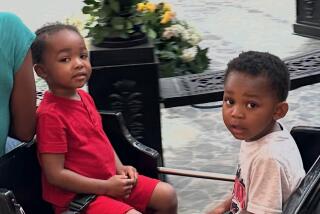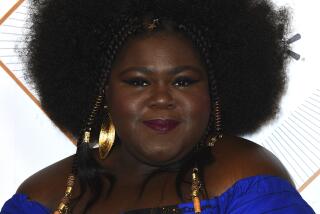Parents of Conjoined Twins Celebrate a Double Blessing
- Share via
LOMA LINDA — When Michelle Roderick learned four months into her pregnancy that she would have conjoined twins--the kind of aberration that P.T. Barnum turned into a carnival sideshow--she spent the evening in tears.
On Wednesday, the world saw her beaming with pride as she gave birth to Shawna Leilani and Janelle Kiana, a pair of beautiful girls who happen to be joined at the abdomen and share liver tissue.
On Friday, Michelle Roderick and her husband, Jeff, explained how they traversed that emotional bridge, turning what could have been regret, bitterness--or even a decision to abort--into a celebration of life.
Today, they’re talking about learning how to breast-feed the babies, about dirty diapers and the girls’ personality differences--how Shawna is lively and outgoing, like mom, and how Janelle is calm and docile, like dad. And they laugh at the possibility that, once separated, the girls may not have belly buttons.
“But they can create belly buttons,” Jeff Roderick announced proudly on behalf of medical science.
Indeed, the Rodericks’ spirit in the wake of giving birth to conjoined twins--a situation that usually leads to the death of one, if not both--was a source of marveling among people who deal with birth defects.
Conjoined twins, which occur about once in 50,000 live births, “is universally accepted as a very serious structural birth defect,” said Michelle Kling, a spokeswoman for the March of Dimes Birth Defects Foundation.
“Normally, parents go through a grieving period for the perfect baby they wanted and didn’t have. They need counseling, sympathy from relatives, and a period of time to understand what is happening,” Kling said. “The response by these parents is extraordinary.”
Michelle Roderick, 29, admitted Friday to heartbreak when she learned after a sonogram in December that her first children were joined in the womb. “Siamese twins” is, after all, a term rooted in ridicule, created by Barnum a century ago to promote the exhibition of Chang and Eng Bunker, conjoined twins born in Siam in 1811.
“I was driving home alone, just crying and asking, ‘Why? Why is this happening to us?’ ”
She sought support immediately, driving instead to the regular gathering of a woman’s prayer group.
“I broke down crying,” she said. “And they all got together and said a prayer and really reached out to me.”
That night, she broke the news to her husband, also 29.
“I said, ‘Remember when the technician said she couldn’t find [during an earlier sonogram] the babies’ membrane? Well, it’s because they’re connected.’ And he said, ‘Well, we’ll have to find out more about this.’ ”
Close friends and family immediately came to their support, and her father, Will Degeraty, a minister, admonished her to be upbeat, Michelle said.
“He said the kids needed me to be positive because it would affect how they turned out,” she said.
The couple took his advice. Their Christmas cards included the sonogram photograph of the unborn girls, showing the two tiny heads side by side.
“Season’s Greetings From the Roderick Kids,” it announced.
And soon there would be no secrets about the Roderick kids in Calexico, the small Imperial County border town where they worked at the 350-student Seventh-day Adventist Mission Academy, she as a science instructor, he as a physical education teacher.
“Everyone here was praying for them,” said Yolanda Johnston, a fellow teacher and close friend. “The school faculty prayed, the Calexico church prayed, we were telling everybody we knew and everyone was praying for them--and Michelle and Jeff knew that this would turn out all right.”
By January, the Rodericks were following the story of Sarah and Sarahi Morales, the Siamese twins just born in Tijuana, joined at the abdomen, chest and liver. Those twins underwent separation surgery 15 days later in San Diego, and Sarahi died within the hour of cardiac arrest.
“I remember thinking the Morales girls looked a lot like how ours did,” she said. “We were praying for them, and I heard they were praying for us too. It really brought it close to home.”
In March, the Rodericks braced themselves for the results of an amniocentesis that would alert them to any genetic disorders.
“How would I deal with that?” Michelle remembered asking herself. “We were offered the option to abort, but we don’t believe in that. I remember reading the Bible the night before we got the amnio results, praying to God to give me the strength to handle whatever happens.”
There were no problems--relieving the couple of a traumatic decision, they said. By this time, simply having conjoined twins wasn’t reason to terminate the pregnancy, they had decided.
All the while, the couple was preparing to move from Calexico to Prescott, Ariz., where Jeff had a new job. Their possessions were in boxes, and her parents set up a temporary nursery at their home in Lake Havasu City, Ariz.
Several weeks ago, Michelle arrived at the Loma Linda University Medical Center to prepare for the delivery.
Already, a 25-member medical team had been assembled, led by Dr. Elmar Sakala, who had delivered three sets of conjoined twins.
The parents allowed the hospital to videotape Wednesday’s delivery--not just for later review by the medical students at Loma Linda, but so that the broader public might learn something, Michelle said.
“I’m a science teacher,” she said. “If something can be learned from this, and people benefit by it, then why not show it?”
Shawna and Janelle were delivered by caesarean section. Their mother watched, thanks to an overhead mirror. Minutes later, she was smiling broadly and caressing the babies’ heads. But because they were covered by blankets, she could not view where their bodies were connected.
That came later, when she was taken to the neonatal intensive care unit.
“I guess you could call it visual shock,” she said. “I thought, ‘Yeah, they’re pretty well-connected.’ ”
But by then, doctors had given their prognosis: Because the girls were connected by the shared tissue of two separate livers--but no other internal organs--a successful separation is anticipated. That surgery will not be done for months, after implanted balloons stretch their skin to facilitate closure of their bellies.
The daily concerns focus on learning how to handle the girls, Michelle said. An elastic band helps hold the twins together to reduce stress on their livers. They are cuddled by mom and dad for up to 90 minutes at a time, resting on a large pillow.
The breast-feeding is a little tricky, Michelle admits.
The Rodericks know they still face the risks of the upcoming surgery.
“It has the potential for being dangerous,” Michelle said. “But we have a lot of confidence in the doctors.
“We’ve been double-blessed with these girls. There are parents out there who face so much more than what we’re facing.”
More to Read
Sign up for Essential California
The most important California stories and recommendations in your inbox every morning.
You may occasionally receive promotional content from the Los Angeles Times.










